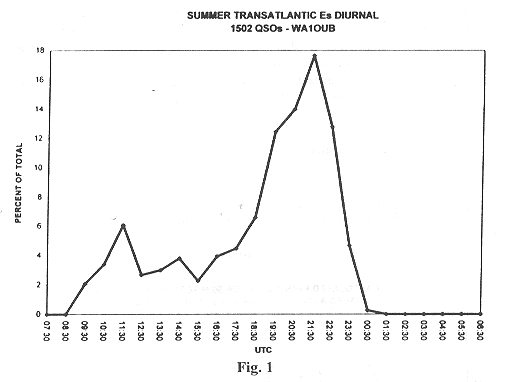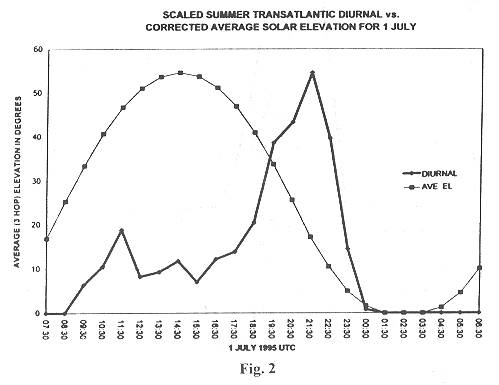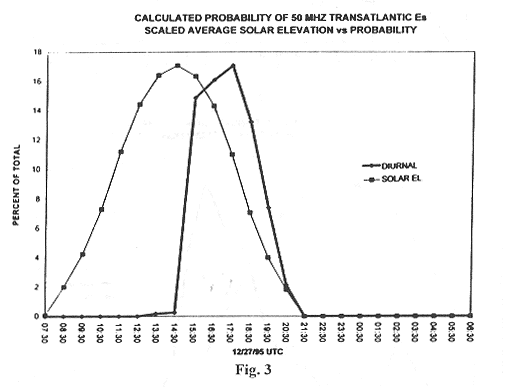

home > archive > propagation theory > winter transatlantic Es

Thanks to all of our authors since 1982!
|
winter
transatlantic Es
|
|||||||||||||||||||
|
This is extremely rare and I thought the timing would be of interest to the 6m DX community. while on the subject of timing, I have plotted the 6m summer diurnal distribution for East Coast to European Es, and used it to try to predict the diurnal distribution for winter Es. The results are interesting:
The first plot (Fig 1) shows UTC times versus QSO rates for each and every transatlantic Es QSO (1502 QSOs) that I have made over the last 10 years. I believed that this plot is the most important of all. The plot covers any QSOs made during the entire summer Es season which runs approx. 1 June through 31 July. The left scale Y axis shows the distribution of contacts in percent, and you can see that the maximum probability is at around 2200z.
This plot (Fig. 2) shows the scaled diurnal variation against the corrected average solar elevations of the three equidistant path midpoints between FN43AD and IN80. The three path midpoints are 105km above grids FN95, HN17, and IN34. Solar elevations were calculated at the ground
and raised 10.3 degrees to account for the better 'view' at
E-layer height, using a formula that compresses the 'lift' at
higher angles. Note that any average elevations that are less
than zero are forced to a zero value.
This may be considered a joke, but not really. The potential solar influence on the summer diurnal for 1 July was estimated using a complex array of polynomials, a Gaussian distribution and interpolation to obtain a 'baseline' formula that fits the summer diurnal nicely. A simple program was written and the results are plotted for 27 Dec 1995. It shows maximum probability occurs around 1800z. I would be interested to It shows how this diurnal compares to the facts. To the best of my knowledge, no 3+ hop winter Es 50MHz QSOs have ever occurred! UKSMG Six News issue 49, May 1996 |
WWV
numbers and F2
D-layer ionoscatter on 50MHz
monitoring 30-50MHz
across the pond
a primer on sporadic-E
E-layer and sporadic-E prop.
the
solar myth
the doughnut effect
troposcatter at 50MHz
50MHz sporadic-E in 1996
cometary origin of
sporadic-E
rattling old bones about sporadic-E
doppler analysis of 6m
signals
tropospheric prop.
at 50MHz
50MHz prop.
between Africa and Europe 1998
analysis of 50MHz contacts
between VK and EU
hidden mode of
sporadic-E?
a crtique of
'hidden mode of sporadic-E?'
6m scatter DX
SV1DH to PY5CC with
1mw
equatorial
propagation
50MHz F2 prop.
mechanisms
more on 50MHz
F2 prop.
observations on Skew-path DX from FM18
 Summer
Transatlantic Es
Summer
Transatlantic Es  Superimposed
average solar elevation for 1 July
Superimposed
average solar elevation for 1 July  Calculated diurnal variation for trans-Atlantic Es on
27 December 1995.
Calculated diurnal variation for trans-Atlantic Es on
27 December 1995.